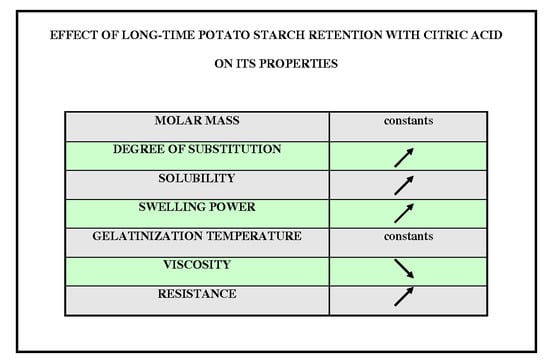Effect of Long-Term Potato Starch Retention with Citric Acid on Its Properties
Abstract
:1. Introduction
2. Discussion of Results
3. Materials and Methods
3.1. Materials
3.2. Production of Modified Starch Preparations
3.3. Determination of the Degree of Substitution
3.4. Determination of the Degree of Substitution (DS) with the Technique of Nuclear Magnetic Resonance 1H NMR
3.5. Molar Mass (Mw) Analysis
3.6. Swelling Power and Solubility of Starch Preparations in Water Having a Temperature of 80 °C
3.7. Determination of the Characteristics of Phase Transitions of Starch Preparations with Differential Scanning Calorimetry (DSC)
3.8. Rheological Properties of Starch Pastes
3.9. Resistance of Starch Preparations to the Action of Amyloglucosidase
3.10. Statistical Analysis
4. Conclusions
Author Contributions
Funding
Institutional Review Board Statement
Informed Consent Statement
Data Availability Statement
Conflicts of Interest
Sample Availability
References
- Fortuna, T.; Gałkowska, D.; Juszczak, L. Porównanie właściwości reologicznych wybranych preparatów skrobi modyfikowanej. Acta Sci. Pol. Technol. Aliment. 2004, 3, 21–32. [Google Scholar]
- Mullen, J.W.; Pascu, E. Starch studies. Preparation and properties of starch triesters. Ind. Eng. Chem. 1942, 34, 1209–1217. [Google Scholar] [CrossRef]
- Kapuśniak, J.; Kapuśniak, K.; Bajer, K. Review of methods for chemical modification of starch. Przemysł Chem. 2011, 90, 1521–1526. [Google Scholar]
- BeMiller, J.; Roy Whistler, R. Starch: Chemistry and Technology, 3rd ed.; Academic Press: Waltham, MA, USA, 2009. [Google Scholar]
- Kapelko-Żeberska, M.; Zięba, T.; Pietrzak, W.; Gryszkin, A. Effect of citric acid esterification conditions on the properties of the obtained resistant starch. Int. J. Food Sci. Technol. 2016, 51, 1647–1654. [Google Scholar] [CrossRef]
- Golachowski, A.; Drożdż, W.; Golachowska, M.; Kapelko-Żeberska, M.; Raszewski, B. Production and properties of starch citrates—Current research. Foods 2020, 9, 1311. [Google Scholar] [CrossRef]
- Zdybel, E. Właściwości preparatów skrobi ziemniaczanej poddanej modyfikacjom chemicznym i prażeniu. Żywność. Nauka. Technologia. Jakość 2006, 13, 18–31. [Google Scholar]
- Radosta, S.; Haberem, M.; Vorwerg, W. Molecular characteristics of amylose and starch in Dimethyl Sulfoxide. Biomacromolecules 2001, 2, 970–978. [Google Scholar] [CrossRef]
- Lee, S.Y.; Lee, K.Y.; Lee, H.G. Effect of different pH conditions on the in vitro digestibility and physicochemical properties of citric acid-treated potato starch. Carbohydr. Polym. 2018, 107, 1235–1241. [Google Scholar] [CrossRef]
- Menzel, C.; Olsson, E.; Plivelic, T.S.; Andersson, R.; Johansson, C.; Kuktaite, R.; Jarnstrom, L.; Koch, K. Molecular structure of citric acid cross-linked starch films. Carbohydr. Polym. 2013, 96, 270–276. [Google Scholar] [CrossRef]
- Zięba, T.; Kapelko, M.; Szumny, A. Effect of preparation method on the properties of potato starch acetates with an equal degree of substitution. Carbohydr. Polym. 2013, 94, 193–198. [Google Scholar] [CrossRef]
- Boruczkowska, H.; Boruczkowski, T.; Tomaszewska-Ciosk, E.; Drożdż, W.; Bienkiewicz, M.; Zołnierczyk, A.; Anioł, M. Enzymatic esterification of starch phosphate with oleic acid. Przemysł Chem. 2013, 92, 1078–1082. [Google Scholar]
- Wishart, D.S.; Tzur, D.; Knox, C.; Eisner, R.; Guo, A.C.; Young, N.; Cheng, D.; Jewell, K.; Arndt, D.; Sawhney, S.; et al. HMDB: The Human Metabolome Database. Nucleic Acids Res. 2007, 35, 521–526. [Google Scholar] [CrossRef]
- Bello-Perez, L.A.; Roger, P.; Baud, B.; Colona, P. Macromolecular features of starches determined by aqueous high-performance size exclusion chromatography. J. Cereal Sci. 1998, 27, 267–278. [Google Scholar] [CrossRef]
- Remya, R.; Jyothia, N.A.; Sreekumar, J. Effect of chemical modification with citric acid on the physicochemical properties and resistant starch formation in different starches. Carbohydr. Polym. 2018, 202, 29–38. [Google Scholar] [CrossRef]
- Hadi, N.A.; Wiege, B.; Stabenau, S.; Marefati, A.; Rayner, M. Comparison of three methods to determine the degree of substitution of quinoa and rice starch acetates, propionates, and butyrates: Direct stoichiometry, FTIR, and H-NMR. Foods 2020, 9, 83. [Google Scholar] [CrossRef] [Green Version]
- Ninni, L.; Meirelles, A.J.A.; Maurer, G. Thermodynamic properties of aqueous solutions of maltodextrins from laser-light scattering, calorimetry and isopiestic investigations. Carbohydr. Polym. 2005, 59, 289–303. [Google Scholar] [CrossRef]
- Hung, P.V.; My, N.T.H.; Phi, N.T.L. Impact of acid and heat-moisture treatment combination on physicochemical characteristics and resistant starch contents of sweet potato and yam starches. Starch 2014, 66, 1013–1021. [Google Scholar] [CrossRef]
- Olsson, E.; Hedenqvist, M.S.; Johansson, C.; Jarnstrom, L. Influence of citric acid and curing moisture sorption, diffusion and permeability of starch films. Carbohydr. Polym. 2013, 94, 765–772. [Google Scholar] [CrossRef]
- Zou, G.X.; Qu, J.P.; Zou, X.L. Optimization of water absorption of starch/PVA composites. Polym. Compos. 2007, 28, 674–679. [Google Scholar] [CrossRef]
- Shi, R.; Bi, J.; Zhang, Z.; Zhy, A.; Chen, D.; Zhou, X.; Zhang, L.; Tian, W. The effect of citric acid on the structural properties and cytotoxicity of the polivinyl alcohol/starch films when molding at high temperature. Carbohydr. Polym. 2008, 74, 763–770. [Google Scholar] [CrossRef]
- Ghanbarzadeh, B.; Almami, H.; Entezami, A.A. Improving the barrier and mechanical properties of corn starch-based edible films: Effect of citric acid and carboxymethyl cellulose. Ind. Crops Prod. 2011, 33, 229–235. [Google Scholar] [CrossRef]
- Fredriksson, H.; Silverio, J.; Andersson, R.; Eliasson, A.C.; Aman, P. The influence of amylose and amylopectin characteristics on gelatinization and retrogradation properties of different starch. Carbohydr. Polym. 1998, 35, 119–134. [Google Scholar] [CrossRef]
- Majzoobi, M.; Beparva, P.; Farahnaky, A.; Badii, F. Effects of malic acid and citric acid on functional properties of native and cross-linked wheat starches. Starch 2014, 66, 491–495. [Google Scholar] [CrossRef]
- Gryszkin, A.; Zięba, T.; Kapelko-Żeberska, M. Hydrothermal modification of wheat starch. PART 2. Thermal characteristics of pasting and rheological properties of pastes. J. Cereal Sci. 2016, 69, 194–198. [Google Scholar] [CrossRef]
- Choudhury, M.D.; Dasb, S.; Tarafdara, S. Effect of loading history on visco-elastic potato starch gel. Colloids Surf. 2016, 492, 47–53. [Google Scholar] [CrossRef]
- Sun, B.; Tian, Y.; Wei, B.; Chena, L.; Bi, Y.; Jin, Z. Effect of reaction solvents on the multi-scale structure of potato starch during acid treatment. Int. J. Biol. Macromol. 2017, 97, 67–75. [Google Scholar] [CrossRef]
- Klaushofer, H.; Berghofer, E.; Steyrer, W. Die Neuentwicklung modifizierter Stärken am Beispiel von Citratstärke. Ernahrung/Nutrition 1978, 2, 51–55. [Google Scholar]
- Buksa, K.; Nowotna, A.; Ziobro, R.; Gambuś, H. Rye flour enriched with arabinoxylans in rye bread making. Food Sci. Technol. Int. 2015, 21, 45–54. [Google Scholar] [CrossRef]
- Praznik, W.; Buksa, K.; Ziobro, R.; Gambuś, H.; Nowotna, A. The effect of long-term alkali treatment on the molecular characteristics of native and extruded starches at 35 °C. Starch 2012, 64, 890–897. [Google Scholar] [CrossRef]
- Richter, M.; Augustat, S.; Schierbaum, F. Ausgewählte Methoden der Stärke Chemie; VEB Fachbuch Verlag: Leipzig, Germany, 1968; pp. 110–112. [Google Scholar]
- Gryszkin, A.; Zięba, T.; Kapelko, M.; Buczek, A. Effect of thermal modifications of potato starch on its selected properties. Food Hydrocoll. 2014, 40, 122–127. [Google Scholar] [CrossRef]
- Zięba, T.; Juszczak, L.; Gryszkin, A. Properties of retrograded and acetylated starch preparations Part 2. Dynamics of saccharification with amyloglucosidase and rheological properties of resulting pastes and gels. LWT—Food Sci. Technol. 2011, 44, 1321–1327. [Google Scholar] [CrossRef]
- Zięba, T.; Kapelko, M.; Gryszkin, A. Selected properties of potato starch subjected to multiple physical and chemical modifications. Pol. J. Food Nutr. Sci. 2007, 57, 639–645. [Google Scholar]
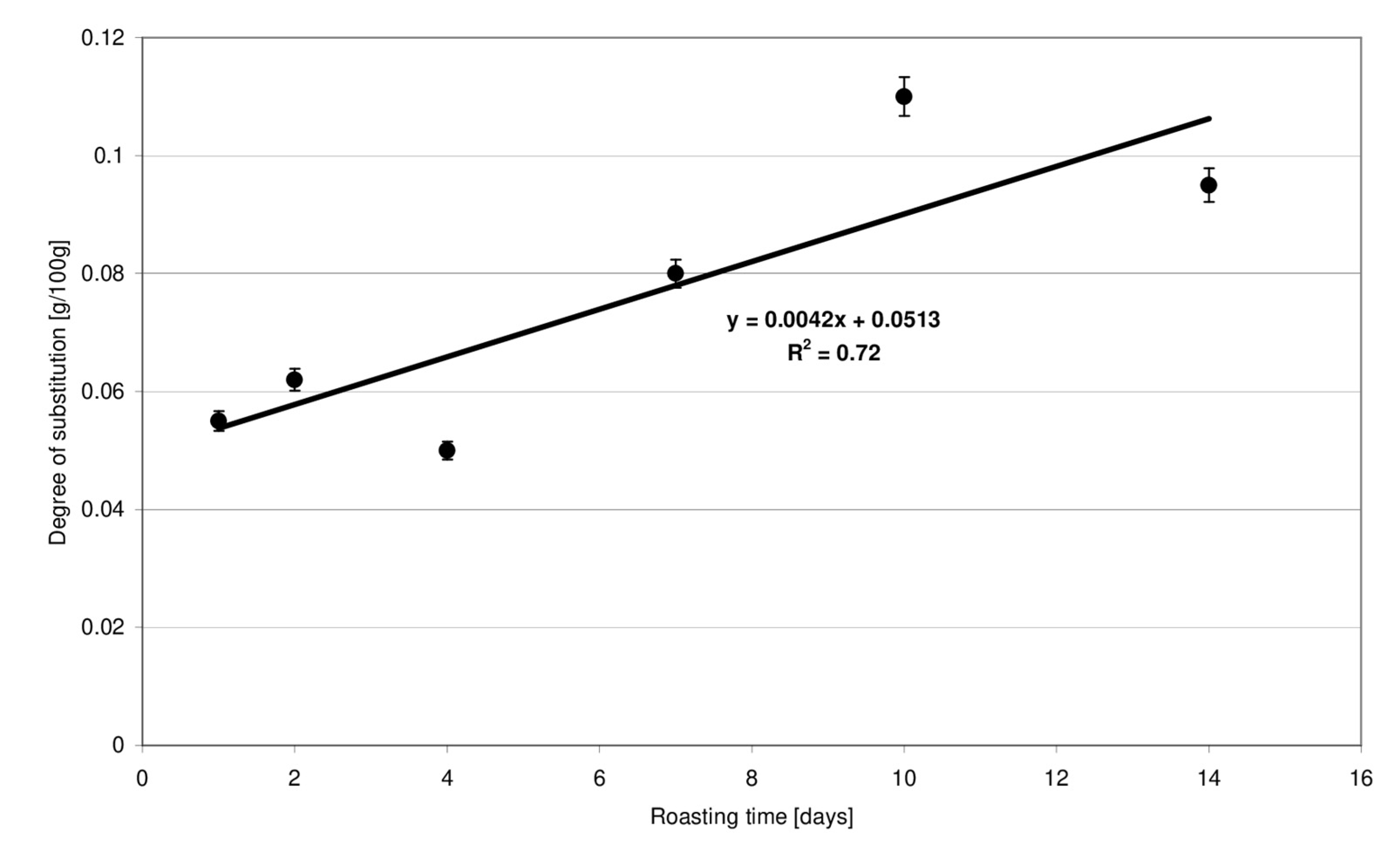
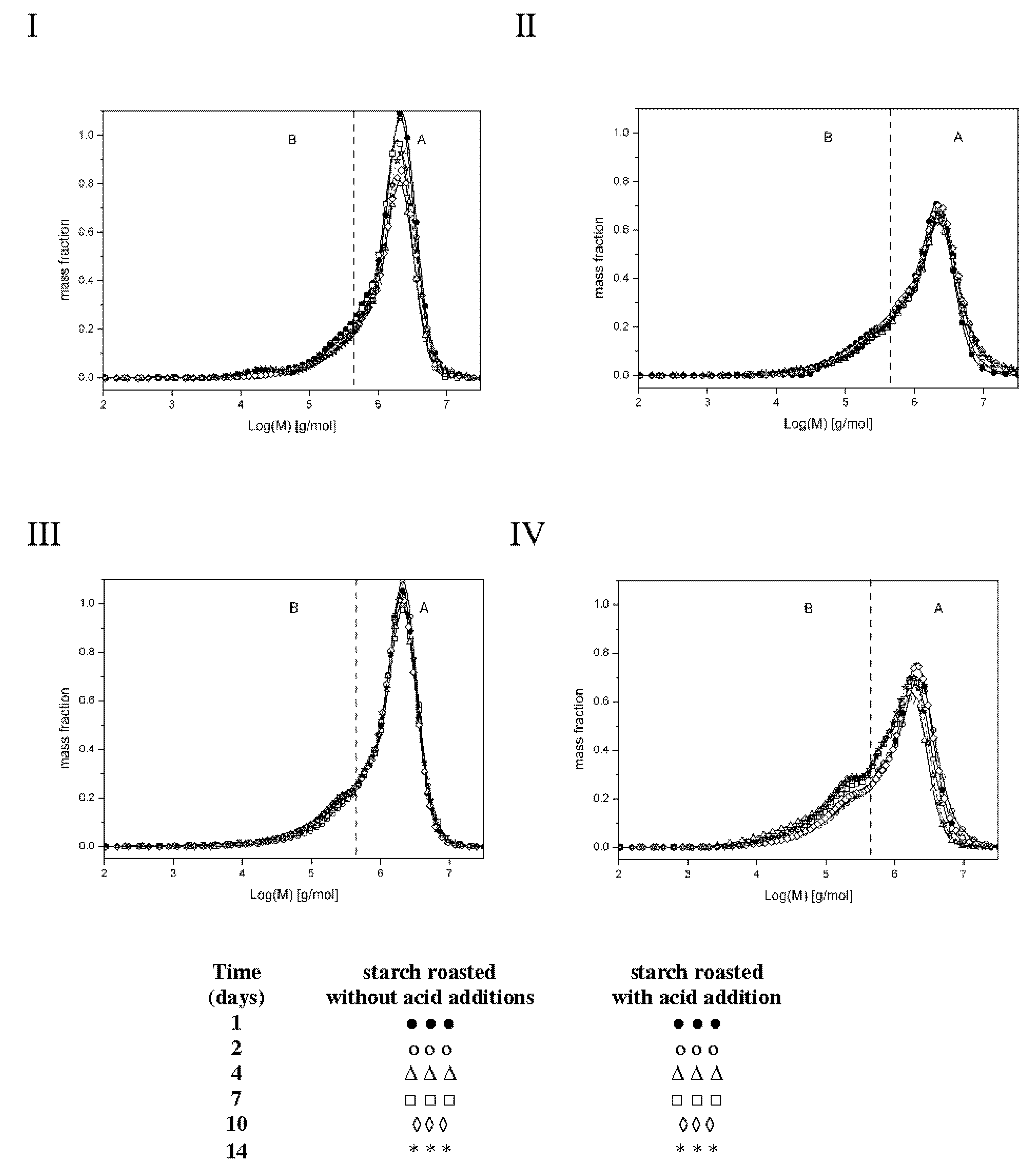
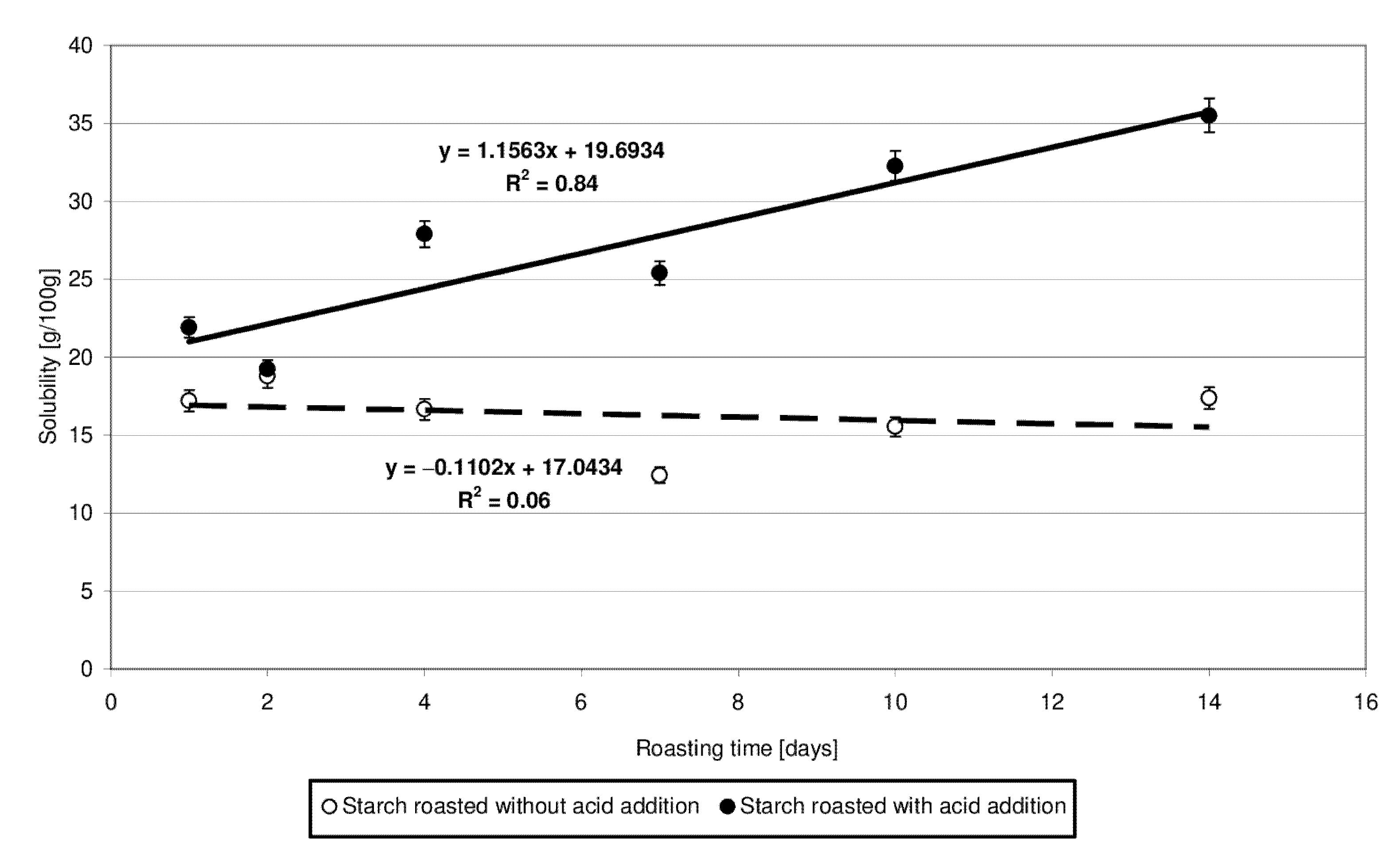
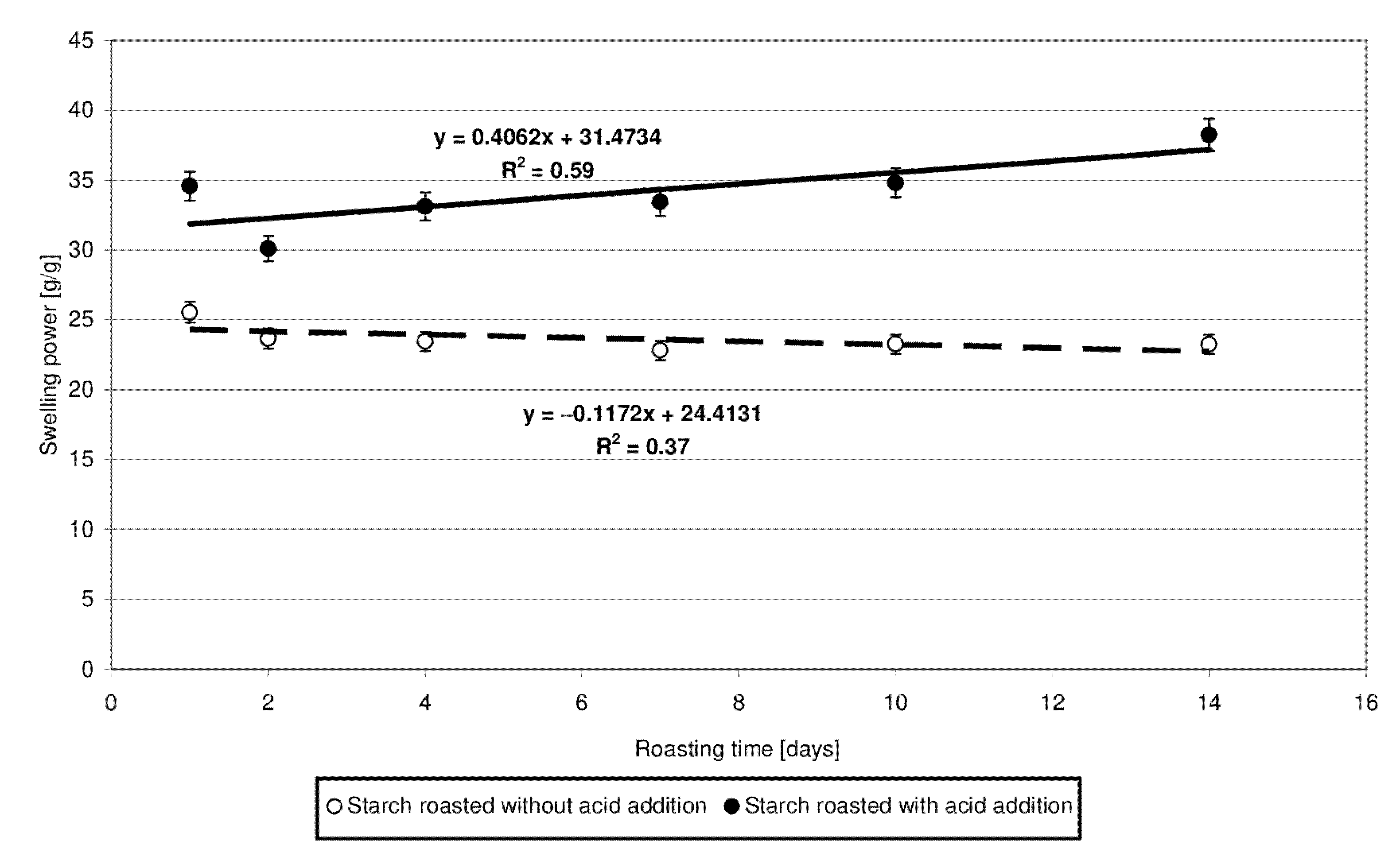



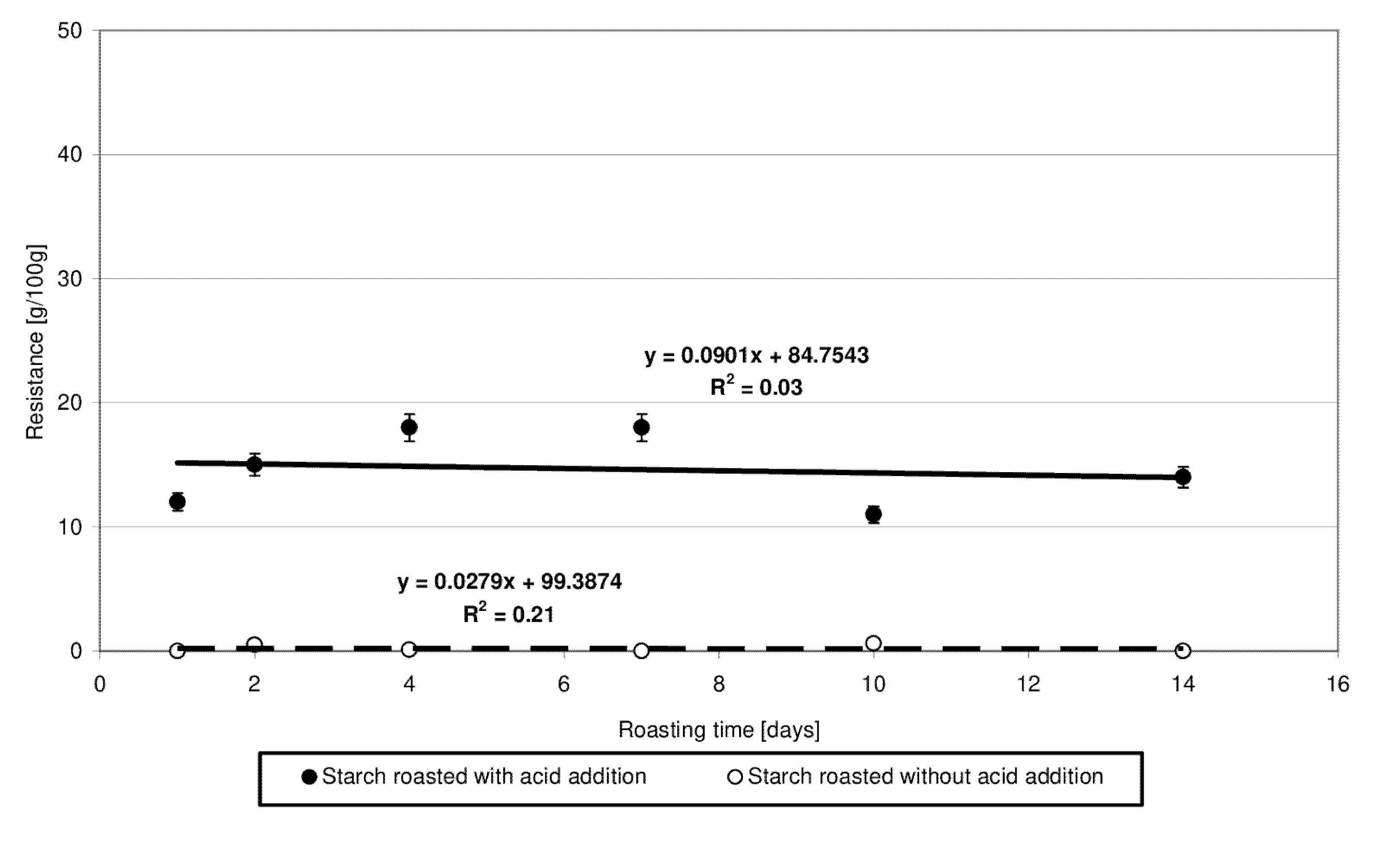
| Time [Days] | Fraction | Solvent Type | |||||||
|---|---|---|---|---|---|---|---|---|---|
| DMSO | NaOH | ||||||||
| Preparation Type | |||||||||
| Without Acid | With Acid | Without Acid | With Acid | ||||||
| Mw × 104 [g/mol] | Đ | Mw × 104 [g/mol] | Đ | Mw × 104 [g/mol] | Đ | Mw × 104 [g/mol] | Đ | ||
| 1 | A | 209.8 | 1.5 | 194.3 | 1.5 | 152.6 | 1.5 | 156.0 | 1.5 |
| B | 20.9 | 5.7 | 20.5 | 3.3 | 19.4 | 2.2 | 18.0 | 2.6 | |
| 2 | A | 203.8 | 1.5 | 200.4 | 1.5 | 168.2 | 1.5 | 170.3 | 1.6 |
| B | 21.4 | 2.7 | 21.9 | 2.1 | 19.4 | 2.2 | 18.4 | 2.6 | |
| 4 | A | 183.2 | 1.4 | 207.0 | 1.5 | 193.0 | 1.7 | 137.8 | 1.4 |
| B | 22.4 | 3.7 | 20.4 | 5.5 | 19.2 | 2.9 | 17.6 | 2.8 | |
| 7 | A | 216.0 | 1.5 | 197.3 | 1.5 | 208.1 | 1.8 | 127.3 | 1.4 |
| B | 20.3 | 3.0 | 20.6 | 2.7 | 18.1 | 2.4 | 16.6 | 2.4 | |
| 10 | A | 212.5 | 1.5 | 192.0 | 1.5 | 204.1 | 1.8 | 156.0 | 1.5 |
| B | 21.9 | 2.2 | 20.9 | 2.1 | 19.1 | 2.2 | 18.0 | 2.6 | |
| 14 | A | 193.9 | 1.5 | 194.9 | 1.5 | 195.6 | 1.7 | 132.0 | 1.5 |
| B | 22.2 | 2.7 | 21.1 | 2.2 | 19.1 | 3.2 | 16.3 | 3.6 | |
Publisher’s Note: MDPI stays neutral with regard to jurisdictional claims in published maps and institutional affiliations. |
© 2022 by the authors. Licensee MDPI, Basel, Switzerland. This article is an open access article distributed under the terms and conditions of the Creative Commons Attribution (CC BY) license (https://creativecommons.org/licenses/by/4.0/).
Share and Cite
Kapelko-Żeberska, M.; Meisel, M.; Buksa, K.; Gryszkin, A.; Szumny, A.; Latacz, B.; Raszewski, B.; Zięba, T. Effect of Long-Term Potato Starch Retention with Citric Acid on Its Properties. Molecules 2022, 27, 2454. https://doi.org/10.3390/molecules27082454
Kapelko-Żeberska M, Meisel M, Buksa K, Gryszkin A, Szumny A, Latacz B, Raszewski B, Zięba T. Effect of Long-Term Potato Starch Retention with Citric Acid on Its Properties. Molecules. 2022; 27(8):2454. https://doi.org/10.3390/molecules27082454
Chicago/Turabian StyleKapelko-Żeberska, Małgorzata, Marta Meisel, Krzysztof Buksa, Artur Gryszkin, Antoni Szumny, Bogna Latacz, Bartosz Raszewski, and Tomasz Zięba. 2022. "Effect of Long-Term Potato Starch Retention with Citric Acid on Its Properties" Molecules 27, no. 8: 2454. https://doi.org/10.3390/molecules27082454
APA StyleKapelko-Żeberska, M., Meisel, M., Buksa, K., Gryszkin, A., Szumny, A., Latacz, B., Raszewski, B., & Zięba, T. (2022). Effect of Long-Term Potato Starch Retention with Citric Acid on Its Properties. Molecules, 27(8), 2454. https://doi.org/10.3390/molecules27082454






